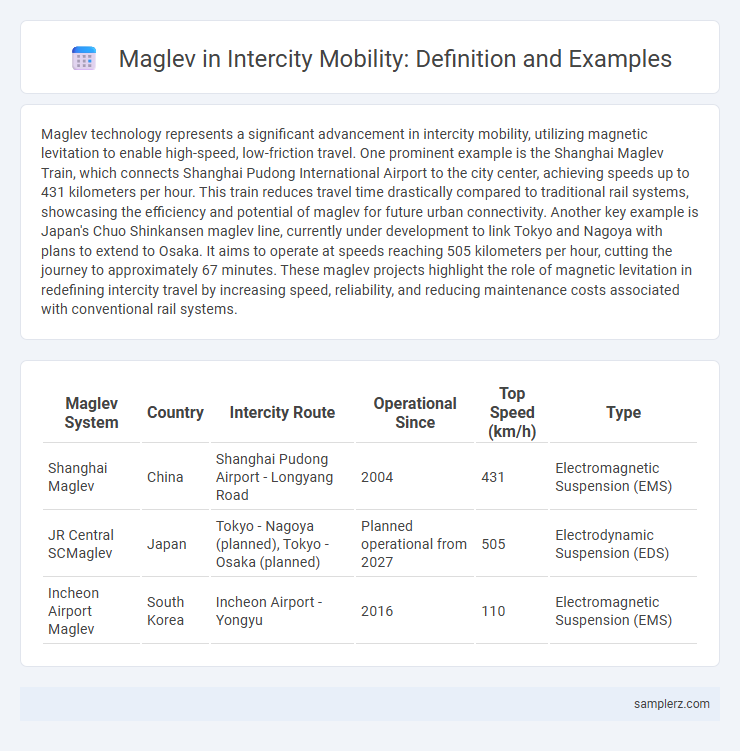Maglev technology represents a significant advancement in intercity mobility, utilizing magnetic levitation to enable high-speed, low-friction travel. One prominent example is the Shanghai Maglev Train, which connects Shanghai Pudong International Airport to the city center, achieving speeds up to 431 kilometers per hour. This train reduces travel time drastically compared to traditional rail systems, showcasing the efficiency and potential of maglev for future urban connectivity. Another key example is Japan's Chuo Shinkansen maglev line, currently under development to link Tokyo and Nagoya with plans to extend to Osaka. It aims to operate at speeds reaching 505 kilometers per hour, cutting the journey to approximately 67 minutes. These maglev projects highlight the role of magnetic levitation in redefining intercity travel by increasing speed, reliability, and reducing maintenance costs associated with conventional rail systems.
Table of Comparison
| Maglev System | Country | Intercity Route | Operational Since | Top Speed (km/h) | Type |
|---|---|---|---|---|---|
| Shanghai Maglev | China | Shanghai Pudong Airport - Longyang Road | 2004 | 431 | Electromagnetic Suspension (EMS) |
| JR Central SCMaglev | Japan | Tokyo - Nagoya (planned), Tokyo - Osaka (planned) | Planned operational from 2027 | 505 | Electrodynamic Suspension (EDS) |
| Incheon Airport Maglev | South Korea | Incheon Airport - Yongyu | 2016 | 110 | Electromagnetic Suspension (EMS) |
Introduction to Maglev Technology in Intercity Mobility
Maglev technology utilizes magnetic levitation to eliminate friction between train and tracks, enabling speeds over 300 mph in intercity travel. Key examples include the Shanghai Maglev Train, which connects Shanghai Pudong Airport to the city center in approximately 7 minutes. This innovation enhances efficiency and reduces travel time, positioning maglev as a transformative solution in high-speed transportation networks.
Historical Overview of Intercity Maglev Systems
The first commercial intercity maglev system, the Shanghai Maglev Train, began operation in 2004, connecting Shanghai Pudong International Airport to the city center with speeds up to 431 km/h. Earlier experimental maglev projects, such as Germany's Transrapid Test Facility in the 1980s, laid the technological foundation for high-speed magnetic levitation transport. Japan's Chuo Shinkansen, currently under development, aims to extend maglev technology to intercity routes with anticipated operational speeds exceeding 500 km/h.
Key Benefits of Maglev for Intercity Travel
Maglev technology offers unparalleled speed, with intercity trains reaching up to 600 km/h, significantly reducing travel time between major urban centers. The low friction and advanced electromagnetic suspension result in quieter and smoother rides, enhancing passenger comfort while minimizing maintenance costs. Energy efficiency and reduced emissions make maglev systems an environmentally sustainable alternative for long-distance transportation.
Global Case Study: Shanghai Maglev Line
The Shanghai Maglev Line, spanning 30 kilometers between Pudong International Airport and Longyang Road Station, exemplifies advanced magnetic levitation technology in intercity travel. Operating at speeds up to 431 km/h, this line significantly reduces travel time and enhances connectivity within the Shanghai metropolitan area. As the world's first commercially operated high-speed maglev system, it sets a benchmark for efficient, sustainable urban mobility solutions globally.
Japan’s Chuo Shinkansen: The Maglev Revolution
Japan's Chuo Shinkansen exemplifies the maglev revolution in intercity mobility, utilizing superconducting magnetic levitation to achieve speeds up to 500 km/h. This advanced transportation system drastically reduces travel time between Tokyo and Nagoya from over 1.5 hours to approximately 40 minutes, enhancing connectivity and economic integration. The Chuo Shinkansen's cutting-edge technology also offers increased energy efficiency and reduced environmental impact compared to conventional high-speed rail.
South Korea’s Urban-to-Intercity Maglev Projects
South Korea's Urban-to-Intercity Maglev Projects showcase advanced magnetic levitation technology designed to connect urban centers with suburban and intercity areas, significantly reducing travel times and enhancing transportation efficiency. The Incheon Airport Maglev line exemplifies successful urban maglev integration, while planned expansions aim to extend high-speed maglev connectivity between major metropolitan regions such as Seoul and Busan. These projects utilize state-of-the-art linear motor propulsion and magnetic levitation, offering quieter, faster, and eco-friendly alternatives to traditional rail systems.
Comparative Analysis: Maglev vs Conventional Rail
Maglev trains achieve speeds exceeding 600 km/h, significantly faster than conventional rail systems averaging 200 km/h, reducing intercity travel times by more than half. Advanced electromagnetic levitation eliminates wheel-rail friction, resulting in smoother rides and lower maintenance costs compared to traditional steel-wheel tracks. Energy efficiency of maglev systems, enhanced by regenerative braking and near-frictionless motion, outperforms diesel and electric conventional trains, making maglev a sustainable alternative for high-speed intercity travel.
Infrastructure Requirements for Intercity Maglev
Intercity maglev systems demand specialized infrastructure featuring elevated guideways with precisely aligned magnetic coils to enable frictionless levitation and propulsion. The construction requires durable, corrosion-resistant materials and extensive ground stabilization to maintain high-speed stability over long distances. Integration with existing transportation hubs is essential for seamless passenger transfer and operational efficiency.
Challenges Facing Maglev Intercity Expansion
Maglev intercity expansion faces significant challenges including extremely high infrastructure costs, extensive land acquisition requirements, and complex technological integration with existing transport networks. Limited routes due to topographical constraints and regulatory hurdles also hinder widespread adoption. Furthermore, public acceptance and securing sustained funding remain critical obstacles in scaling maglev systems beyond pilot projects.
The Future Outlook for Maglev in Intercity Mobility
Maglev technology promises transformative advancements in intercity mobility by enabling trains to travel at speeds exceeding 300 mph, significantly reducing travel time between major urban centers. Future developments focus on expanding maglev networks across high-density corridors in Asia and Europe, driven by investments totaling billions in infrastructure and innovation. The integration of maglev systems with smart transportation networks is set to enhance energy efficiency, reduce greenhouse gas emissions, and support sustainable urban growth.

example of maglev in intercity Infographic
 samplerz.com
samplerz.com